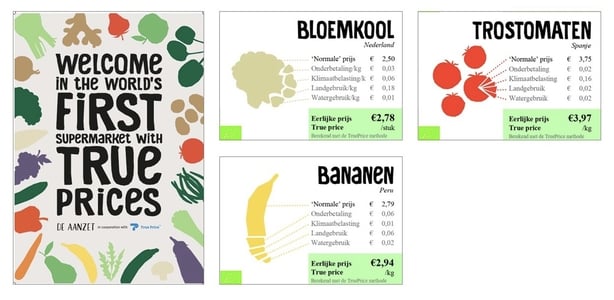Analysis: the percentage of our income spent on food can range from 10% to 25% depending on our level of wealth
Every week, our local discount supermarket tempts us with a new selection of "Super Savers". One week in September, we found large signage just inside the door displaying the original price, the reduced price and the potential super-saving. This particular week, it's white potatoes, a salad trio, spring onions, fun-size apples, plums and avocados. Further inside, other supersavers are found in the refrigerated section when searching for our meat protein for the week. This week it is steak, chicken and duck.
Taking a deeper look reveals that most of the fruit and vegetables are not organic and imported while the meat is mostly home-produced. The potential super-saving ranges from 12 to 71%, a considerable amount and difficult to resist especially taking into account the current cost of living crisis with rising food costs every week.
We need your consent to load this rte-player contentWe use rte-player to manage extra content that can set cookies on your device and collect data about your activity. Please review their details and accept them to load the content.Manage Preferences
From RTÉ Radio 1's Morning Ireland, Prof Thia Hennessy from UCC on a new report which finds food prices in Ireland remain high in an international context
Aside from price, we are often tempted to support more sustainable food by seeking out locally grown, healthy, quality food. Many sustainable products like organic food sell at a premium and appear to be the more expensive alternative. Sustainability is complex and difficult to communicate. Klaus Grunert, an expert in consumer behaviour from Aarhus University contends that sustainability for most consumers is not the main reason they buy a food product. Taste, price, family acceptance, health often come before. It is estimated that the transition to a healthy and sustainable diet could be 6% or more expensive than the current global consumption pattern and therefore less affordable for many.
According to Safefood, "sustainable healthy diets need to consider health and sociocultural aspects as well as environmental impacts". Yet Safefood's 2023 study in Ireland shows that many families struggle to buy healthy food: the cost of a healthy food basket as a percentage of take-home pay needs to be in the region 13 to 32% of your takehome pay for lower income households.
Mintel's Consumer and Cost of Living Survey in the Republic of Ireland (June 2023) found Irish people appear to be cutting back spending on food, with some significant changes such as keeping "to a stricter shopping list"; making their "own lunch rather than buying it from a food outlet" and shopping at discount stores.
We need your consent to load this rte-player contentWe use rte-player to manage extra content that can set cookies on your device and collect data about your activity. Please review their details and accept them to load the content.Manage Preferences
From RTÉ Radio 1's Drivetime, families under increasing pressure to buy healthy food
But how much do we actually spend on food? The percentage of our income spent on food can range from 10% to 25% depending on our level of wealth. Wealthier people tend to spend more money on food in absolute terms, but a smaller share of their overall income (and expenditure), a phenomenon known as "Engel's Law". At lower income levels, people rely more on cheaper staples. As people become richer, they can afford other foods such as fruits, vegetables, legumes, meat and dairy which are higher in macro and micronutrients.
While the discounters offer healthy and more affordable fruit and vegetables on the face of it, what have we not included in the price? Economists often talk about hidden costs. The complexity of the food supply chain allows for many layers with each taking a cut. Using promotional tools, in the case of discounters, promotional pricing, can often hide the true cost of the product.

But what precisely is the true cost or the true price of a food product? De Aanzet is a supermarket based in Amsterdam pioneering this concept with their food pricing strategy. Their mission is to communicate the true price by displaying the market price together with all other hidden costs on the price tag of the food products they sell. Aanzet owner Maarten Rijninks says they were one of the first shops to sell organic produce in 1981 and the first to sell true-price products in 2020. Deloitte Netherlands, one of the "Big 4" accountancy firms is following suit with their True Price Coffee Bar.
These true prices have been calculated by True Price™, a social enterprise established in 2012 by Michel Scholte and Adrian de Groot Ruiz. Scholte defines a true price as "the market price plus the social and environmental costs in the whole value chain of a product. For example the costs due to carbon emissions and climate change or the costs due to the underpayment or under earning of workers and farmers and the poverty that comes from that".
True prices help us understand external social and environmental costs associated with food production, offering consumers a choice by providing information about the sustainability of their choice. The nearer the market price comes to the true price, the more sustainable a product is.
Smaller independent food suppliers struggle to compete with large discount retailers on price. However, shorter supply chains, alternative and more direct-to-consumer models can help reduce external costs and offer an opportunity where both producer and consumer benefit. The producer can earn a fair premium and the consumer pays a truer price. While at first glance, it may appear that this approach will simply make everything more expensive, in fact, the objective is to make the food we buy and eat more sustainable.
The views expressed here are those of the author and do not represent or reflect the views of RTÉ



